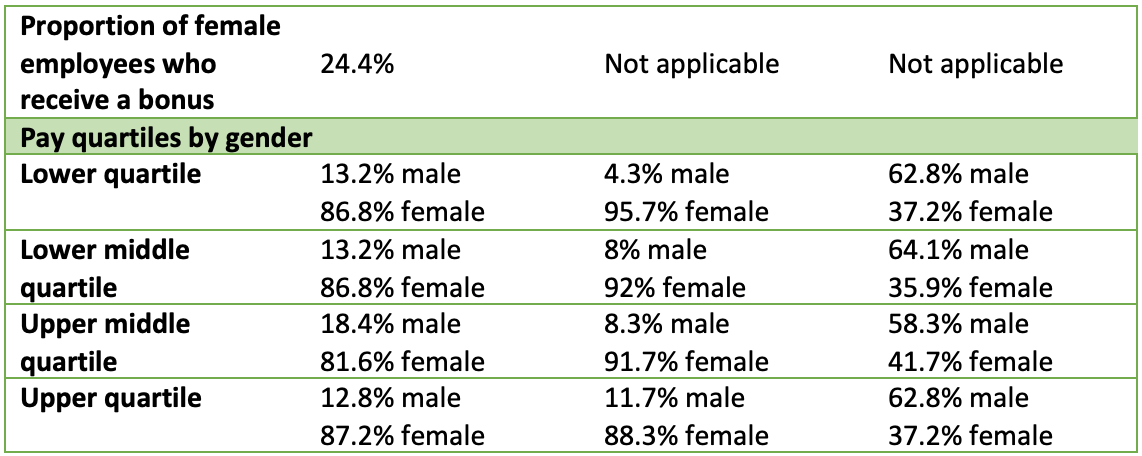Gender Pay Gap Report (2019)
Gender Pay Gap Report
March 2019
Context
Hales Group Limited employ more than 250 people and therefore we are publishing this annual gender pay gap report in line with our obligations to show the difference in average female earnings compared to average male earnings over a standard time period, regardless of role seniority.
This report outlines the position within our organisation for the snapshot date of 5 April 2018.
As per our previous report, we have broken down our calculations because we operate in a number of uniquely different employment sectors, and the jobs and levels of pay and bonuses are not clearly comparable. We have, however, also provided an indication of the gender pay gap within our overall organisation.
Hales Group’s total workforce continues to consist of significantly more females (75%) than males (25%). This profile reflects industry trends for care delivery and administrative staff within the health and social care sector and is not unique to our organisation, nor is it reflective of any recruiting policies or aims, it merely reflects the principle demographic of the interested and available workforce in this sector.
Our gender pay gap results should be considered in the context of this distribution as the predominance of females to males has an influence on our overall gender pay gap figures.


Key findings – Office based / salaried staff
We are very pleased that we have slightly lowered our mean pay gap compared to last year’s findings. The data shows there is only a 4.2% mean gender pay gap in this staff grouping.
Women make up 86% of our office based/salaried workforce and 80% of the top 10% highest earners in this grouping.
The median gender pay gap has reduced to 5.9% which is significantly lower than the UK average, which sat at 8.6% in 2018 according to the Office for National Statistics.
There are a lower representation of female employees in the lower and lower middle quartiles. The representation of women in the upper and upper middle quartiles is still proportionate to their representation in the workforce as a whole.
We continue to have a positive gender pay gap report due to our ongoing commitment to diversity and inclusion.
Bonus pay gaps
Bonus payments are only applicable to office based/salaried staff. The proportion of males versus females receiving bonuses (26.1% versus 24.4%) is marginal and shows that male relevant employees are no more or less likely to receive any amount of bonus payment compared to female relevant employees.
The mean bonus gender pay gap is attributed to one male employee earning a particularly high level of bonus in the reporting period which adversely affects the weight of the average male bonus and therefore increasing our mean bonus gender pay gap for this snapshot. The significant negative median bonus pay gap is attributable of the fact that the majority of higher bonus earners in the Group are female and this is indicative of our overall predominance of females within our workforce.
Key findings – Home Care Workers
There remains a near-zero percentage figure for the mean pay gap in this group of employees with the distribution of males and females fluctuating slightly in the upper and lower quartiles. This is due to the fact that employees are concentrated in the same pay grade, which evidences no gap between the pay of typical male and female employees and therefore equal pay overall. Pay rates in the sector are largely dictated by local authority contracts and funding for community care as well as prevailing National Minimum Wage legislation.
Key findings – Employees undertaking temporary assignments
This grouping of employees remains more evenly balanced {63% male to 37% female) however we are pleased to report a significantly lower gender pay gap.
In this group of employees the mean gender pay gap is 1.9% and median gender pay gap is -0.9%. The reduction in our gender pay gap is due to the closure of a client with volume staff usage, employing a number of high earning roles therefore the distribution of male and female workers in all quartiles is now more evenly balanced.
Overall summary
The overall mean gender pay gap is 2.4% and the overall median gender pay gap is 1.87% – both significantly lower than the UK average.
Objectives
The results of our gender pay gap analysis are extremely positive again this year and we will strive to maintain these results by maintaining our commitment to pay parity in comparable roles and continually reviewing our diversity and equality initiatives.
Statement
I confirm that Hales Group Limited is committed to the principle of gender pay equality and has prepared its 2018 gender pay gap results in line with mandatory requirements.
I confirm that the information in this statement is accurate.
Kate Parkington
Group HR Manager
















